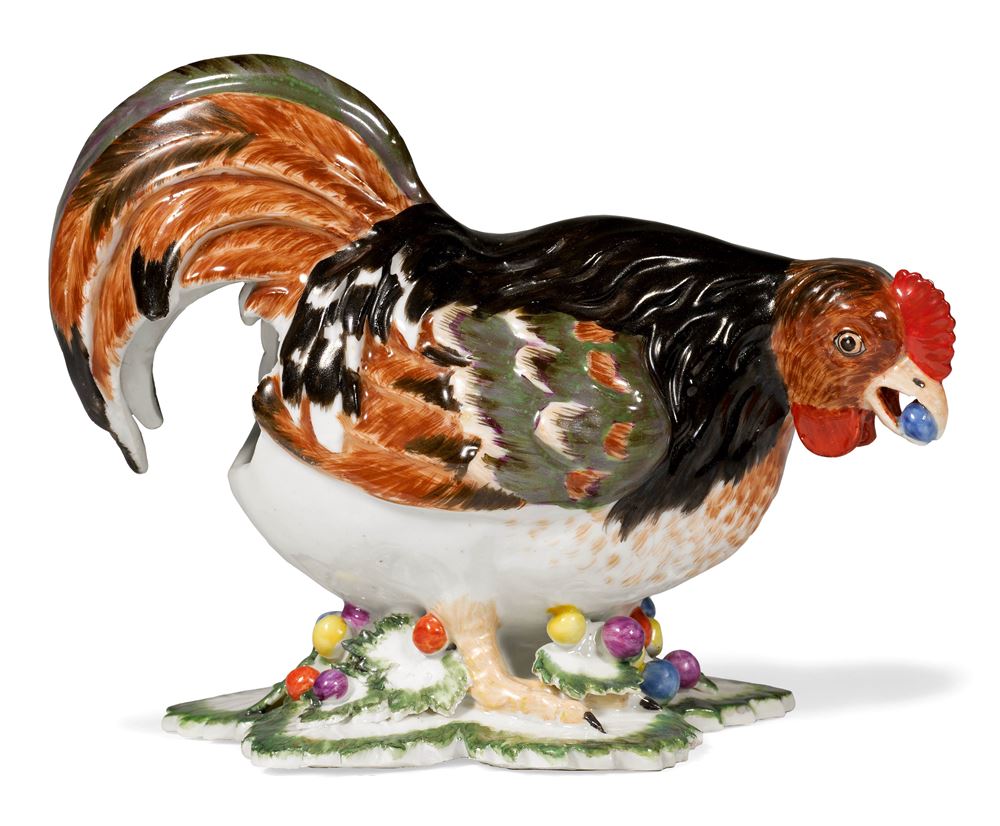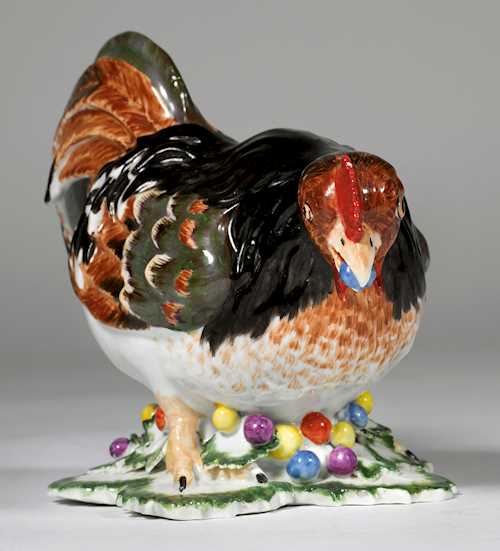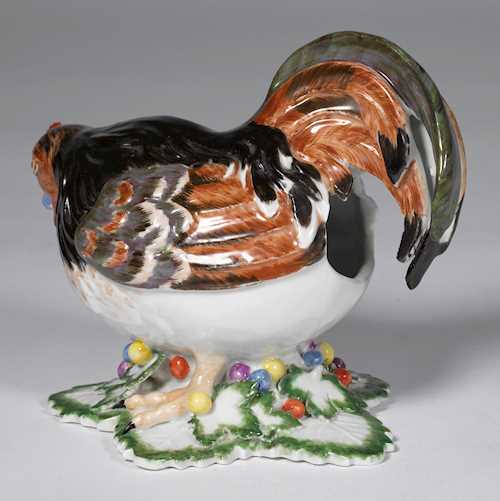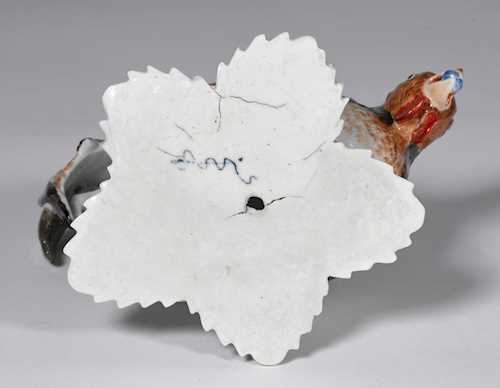
Lot 1059* - A202 Decorative Arts - Thursday, 22. September 2022, 10.00 AM
RARE TEAPOT DESIGNED AS A JAPANESE BANTAM COCK
Meissen, ca. 1730. Model by J. G. Kirchner, the painting later, probably ca. 1735.
On a flat base, designed as a vine leaf with a green rim. The curved tail feathers cover an open back for pouring in the tea, which is served from the beak, in which the cock holds a blue kernel. The plumage is naturalistically staffed in dark brown, russet, and green over purple, the comb and the beak are painted red. The colorful kernels are painted in red, yellow and blue. Blue caduceus mark on the unglazed bottom.
H 15 cm, L 19 cm.
Restorations
Provenance:
- Christie's Geneva, Important European Porcelain, 13 May 1985, Lot No. 129.
- formerly E&H Manners, Ceramics & Works of Art, London.
The first Meissen model-master Johann Gottlieb Kirchner (1706-68) used a Japanese model from the 17th century in Arita porcelain as a model for this rare and early Bantam cock teapot.
C. Kirsch (Jubiläumskatalog Langeloh Porcelain, 2019, pp. 400-409) and Julia Weber (Meissen Porcelains after East Asian Models, Vol. I, 2013, pp. 52-55) devoted extensive studies to this model, on which the following notes are based.
The Meissen replica of the coveted Japanese model was specially commissioned by the French "Marchand Mercier" Rudolphe Lemaire for the Paris art market, in order to later sell it as a Japanese original, most profitably, to his French clientele.
Japanese bantam cocks were among the most sought-after porcelains among Parisian society and fetched top prices, e.g. at an auction of the Fonspertius Collection held by the famous Parisian art dealer Gersaint in 1747, where it sold for a record price of 428 livres (Weber 2013, I, pp. 53f.).
Since the thoroughly kept Archives of the Electoral Collections in Dresden (see Boltz, Hoym, Lemaire and Meissen, Keramos 88/1980, p. 5f.) do not attest to any Japanese original in the Collections of Augustus the Strong, Lemaire must have brought the Japanese bantam teapot from Paris to Dresden himself, in order to commission replicas made of Meissen porcelain.
Most of these Meissen models bear the rare caduceus mark. For the Parisian customers, the actual Saxon origin was concealed in this manner, and the teapots with their Asian-looking mark could be passed off as Japanese originals.
Only a few comparative models of this bantam cock exist. In the porcelain collection of the Schwerin State Museum (Möller 2006) and in the Ernst Schneider Collection in Lustheim Castle (Weber 2013), there are three examples also painted in darker, naturalistic colors, similar to the animal in nature, which are considered to be painted later. Other known comparative models, in public and private collections, imitate the Japanese model in bright Kakiemon colors.
Comparative items:
- Laurence S. Rockefeller Collection (Sothebys New York, 11 October 2005, Lot Nos. 316-317, $508,800).
- Irwin Untermyer Collection, Metropolitan Museum of Art, New York (Y. Hackenbroch 1956, Ill. 18, Plate 13).
- Drach Collection (Ball & Graupe Auction 15 March 1933, 77 Meissen porcelain birds).
- Collection Ernst Schneider, Lustheim Castle (Rückert 1966, Nos. 1133 and 1134 and Weber 2013, Vol. I, p. 54, Ill. 25).
- Moritzburg Castle (Albiker 1959, No. 112).
- Lesley and Emma Sheafer Collection, Metropolitan Museum New York (Y. Hackenbroch 1954, No. 4).
- Landesmuseum Schwerin (Möller 2006).
- Elfriede Langeloh, formerly Jules Desurmont Collection, Northern France.
The model on offer was cited as a comparative item for the catalog entry on the Meissen bantam cock in the Rockefeller Collection and those in the Schneider Collection at Lustheim Castle, due to the dark painting (Sotheby's New York 2005, Lot Nos. 316 and 317).
Provenance:
- Christie's Geneva, Important European Porcelain, 13 May 1985, Lot No. 129.
- formerly E&H Manners, Ceramics & Works of Art, London.
The first Meissen model-master Johann Gottlieb Kirchner (1706-68) used a Japanese model from the 17th century in Arita porcelain as a model for this rare and early Bantam cock teapot.
C. Kirsch (Jubiläumskatalog Langeloh Porcelain, 2019, pp. 400-409) and Julia Weber (Meissen Porcelains after East Asian Models, Vol. I, 2013, pp. 52-55) devoted extensive studies to this model, on which the following notes are based.
The Meissen replica of the coveted Japanese model was specially commissioned by the French "Marchand Mercier" Rudolphe Lemaire for the Paris art market, in order to later sell it as a Japanese original, most profitably, to his French clientele.
Japanese bantam cocks were among the most sought-after porcelains among Parisian society and fetched top prices, e.g. at an auction of the Fonspertius Collection held by the famous Parisian art dealer Gersaint in 1747, where it sold for a record price of 428 livres (Weber 2013, I, pp. 53f.).
Since the thoroughly kept Archives of the Electoral Collections in Dresden (see Boltz, Hoym, Lemaire and Meissen, Keramos 88/1980, p. 5f.) do not attest to any Japanese original in the Collections of Augustus the Strong, Lemaire must have brought the Japanese bantam teapot from Paris to Dresden himself, in order to commission replicas made of Meissen porcelain.
Most of these Meissen models bear the rare caduceus mark. For the Parisian customers, the actual Saxon origin was concealed in this manner, and the teapots with their Asian-looking mark could be passed off as Japanese originals.
Only a few comparative models of this bantam cock exist. In the porcelain collection of the Schwerin State Museum (Möller 2006) and in the Ernst Schneider Collection in Lustheim Castle (Weber 2013), there are three examples also painted in darker, naturalistic colors, similar to the animal in nature, which are considered to be painted later. Other known comparative models, in public and private collections, imitate the Japanese model in bright Kakiemon colors.
Comparative items:
- Laurence S. Rockefeller Collection (Sothebys New York, 11 October 2005, Lot Nos. 316-317, $508,800).
- Irwin Untermyer Collection, Metropolitan Museum of Art, New York (Y. Hackenbroch 1956, Ill. 18, Plate 13).
- Drach Collection (Ball & Graupe Auction 15 March 1933, 77 Meissen porcelain birds).
- Collection Ernst Schneider, Lustheim Castle (Rückert 1966, Nos. 1133 and 1134 and Weber 2013, Vol. I, p. 54, Ill. 25).
- Moritzburg Castle (Albiker 1959, No. 112).
- Lesley and Emma Sheafer Collection, Metropolitan Museum New York (Y. Hackenbroch 1954, No. 4).
- Landesmuseum Schwerin (Möller 2006).
- Elfriede Langeloh, formerly Jules Desurmont Collection, Northern France.
The model on offer was cited as a comparative item for the catalog entry on the Meissen bantam cock in the Rockefeller Collection and those in the Schneider Collection at Lustheim Castle, due to the dark painting (Sotheby's New York 2005, Lot Nos. 316 and 317).
CHF 26 000 / 30 000 | (€ 26 800 / 30 930)
Sold for CHF 32 020 (including buyer’s premium)
All information is subject to change.





